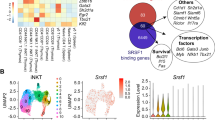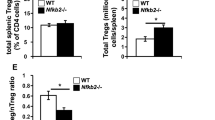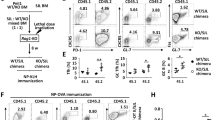Abstract
The interplay between the CD4-lineage transcription factor ThPok and the CD8-lineage transcription factor, runt-related transcription factor 3 (Runx3), in T-cell development has been extensively documented. However, little is known about the roles of these transcription factors in invariant natural killer T (iNKT) cell development. CD1d-restricted iNKT cells are committed to the CD4+CD8− and CD4−CD8− sublineages, which respond to antigen stimulation with rapid and potent release of T helper (Th) 1 and Th2 cytokines. However, previous reports have demonstrated a new population of CD8+ NKT cells in ThPok-deficient mice. In the current study, we sought to determine whether Runx3 was involved in the re-expression of CD8 and function of iNKT cells in the absence of ThPok. We used mice lacking Runx3, ThPok or both and verified that Runx3 was partially responsible for the appearance of CD8+ iNKT cells in ThPok knockout mice. Additionally, Runx3 participated in the immune response mediated by iNKT cells in a model of α-galactosylceramide-induced acute hepatitis. These results indicate that Runx3 is crucial for the phenotypic and functional changes observed in ThPok-deficient iNKT cells.
This is a preview of subscription content, access via your institution
Access options
Subscribe to this journal
Receive 12 digital issues and online access to articles
$119.00 per year
only $9.92 per issue
Buy this article
- Purchase on Springer Link
- Instant access to full article PDF
Prices may be subject to local taxes which are calculated during checkout





Similar content being viewed by others
References
Godfrey DI, Stankovic S, Baxter AG . Raising the NKT cell family. Nat Immunol 2010; 11: 197–206.
Santodomingo-Garzon T, Swain MG . Role of NKT cells in autoimmune liver disease. Autoimmun Rev 2011; 10: 793–800.
Godfrey DI, Berzins SP . Control points in NKT-cell development. Nat Rev Immunol 2007; 7: 505–518.
Egawa T, Eberl G, Taniuchi I, Benlagha K, Geissmann F, Hennighausen L et al. Genetic evidence supporting selection of the Valpha14i NKT cell lineage from double-positive thymocyte precursors. Immunity 2005; 22: 705–716.
Bendelac A, Savage PB, Teyton L . The biology of NKT cells. Annu Rev Immunol 2007; 25: 297–336.
Kronenberg M . Toward an understanding of NKT cell biology: progress and paradoxes. Annu Rev Immunol 2005; 23: 877–900.
Ho LP, Urban BC, Jones L, Ogg GS, McMichael AJ . CD4−CD8alphaalpha subset of CD1d-restricted NKT cells controls T cell expansion. J Immunol 2004; 172: 7350–7358.
Rogers PR, Matsumoto A, Naidenko O, Kronenberg M, Mikayama T, Kato S . Expansion of human Valpha24+ NKT cells by repeated stimulation with KRN7000. J Immunol Methods 2004; 285: 197–214.
Takahashi T, Chiba S, Nieda M, Azuma T, Ishihara S, Shibata Y et al. Cutting edge: analysis of human V alpha 24+CD8+ NK T cells activated by alpha-galactosylceramide-pulsed monocyte-derived dendritic cells. J Immunol 2002; 168: 3140–3144.
Gumperz JE, Miyake S, Yamamura T, Brenner MB . Functionally distinct subsets of CD1d-restricted natural killer T cells revealed by CD1d tetramer staining. J Exp Med 2002; 195: 625–636.
Lee PT, Benlagha K, Teyton L, Bendelac A . Distinct functional lineages of human V(alpha)24 natural killer T cells. J Exp Med 2002; 195: 637–641.
Doisne JM, Becourt C, Amniai L, Duarte N, Le Luduec JB, Eberl G et al. Skin and peripheral lymph node invariant NKT cells are mainly retinoic acid receptor-related orphan receptor (gamma)t+ and respond preferentially under inflammatory conditions. J Immunol 2009; 183: 2142–2149.
Coquet JM, Chakravarti S, Kyparissoudis K, McNab FW, Pitt LA, McKenzie BS et al. Diverse cytokine production by NKT cell subsets and identification of an IL-17-producing CD4–NK1.1–NKT cell population. Proc Natl Acad Sci USA 2008; 105: 11287–11292.
Michel ML, Keller AC, Paget C, Fujio M, Trottein F, Savage PB et al. Identification of an IL-17-producing NK1.1neg iNKT cell population involved in airway neutrophilia. J Exp Med 2007; 204: 995–1001.
Constantinides MG, Bendelac A . Transcriptional regulation of the NKT cell lineage. Curr Opin Immunol 2013; 25: 161–167.
Terashima A, Watarai H, Inoue S, Sekine E, Nakagawa R, Hase K et al. A novel subset of mouse NKT cells bearing the IL-17 receptor B responds to IL-25 and contributes to airway hyperreactivity. J Exp Med 2008; 205: 2727–2733.
Watarai H, Sekine-Kondo E, Shigeura T, Motomura Y, Yasuda T, Satoh R et al. Development and function of invariant natural killer T cells producing Th2- and Th17-cytokines. PLoS Biol 2012; 10: e1001255.
Lee YJ, Holzapfel KL, Zhu J, Jameson SC, Hogquist KA . Steady-state production of IL-4 modulates immunity in mouse strains and is determined by lineage diversity of iNKT cells. Nat Immunol 2013; 14: 1146–1154.
Brennan PJ, Brigl M, Brenner MB . Invariant natural killer T cells: an innate activation scheme linked to diverse effector functions. Nat Rev Immunol 2013; 13: 101–117.
Savage AK, Constantinides MG, Han J, Picard D, Martin E, Li B et al. The transcription factor PLZF directs the effector program of the NKT cell lineage. Immunity 2008; 29: 391–403.
Kovalovsky D, Uche OU, Eladad S, Hobbs RM, Yi W, Alonzo E, Chua K et al. The BTB-zinc finger transcriptional regulator PLZF controls the development of invariant natural killer T cell effector functions. Nat Immunol 2008; 9: 1055–1064.
He X, Dave VP, Zhang Y, Hua X, Nicolas E, Xu W et al. The zinc finger transcription factor Th-POK regulates CD4 versus CD8 T-cell lineage commitment. Nature 2005; 433: 826–833.
Sun G, Liu X, Mercado P, Jenkinson SR, Kypriotou M, Feigenbaum L et al. The zinc finger protein cKrox directs CD4 lineage differentiation during intrathymic T cell positive selection. Nat Immunol 2005; 6: 373–381.
Wildt KF, Sun G, Grueter B, Fischer M, Zamisch M, Ehlers M et al. The transcription factor Zbtb7b promotes CD4 expression by antagonizing Runx-mediated activation of the CD4 silencer. J Immunol 2007; 179: 4405–4414.
Wang L, Carr T, Xiong Y, Wildt KF, Zhu JF, Feigenbaum L et al. The sequential activity of Gata3 and Thpok is required for the differentiation of CD1d-restricted CD4+ NKT cells. Eur J Immunol 2010; 40: 2385–2390.
Engel I, Hammond K, Sullivan BA, He X, Taniuchi I, Kappes D et al. Co-receptor choice by Vα14i NKT cells is driven by Th-POK expression rather than avoidance of CD8-mediated negative selection. J Exp Med 2010; 207: 1015–1029.
Engel I, Hammond K, Sullivan BA, He X, Taniuchi I, Kappes D et al. The transcription factor Th-POK negatively regulates Th17 differentiation in Valpha14i NKT cells. Blood 2012; 120: 4524–4532.
Egawa T, Littman DR . ThPOK acts late in specification of the helper T cell lineage and suppresses Runx-mediated commitment to the cytotoxic T cell lineage. Nat Immunol 2008; 9: 1131–1139.
Woolf E, Xiao C, Fainaru O, Lotem J, Rosen D, Negreanu V et al. Runx3 and Runx1 are required for CD8 T cell development during thymopoiesis. Proc Natl Acad Sci USA 2003; 100: 7731–7736.
Grueter B, Petter M, Egawa T, Laule-Kilian K, Aldrian CJ, Wuerch A et al. Runx3 regulates integrin alpha E/CD103 and CD4 expression during development of CD4−/CD8+ T cells. J Immunol 2005; 175: 1694–1705.
Wong WF, Kurokawa M, Satake M, Kohu K . Down-regulation of Runx1 expression by TCR signal involves an autoregulatory mechanism and contributes to IL-2 production. J Biol Chem 2011; 286: 11110–11118.
Egawa T, Tillman RE, Naoe Y, Taniuchi I, Littman DR . The role of the Runx transcription factors in thymocyte differentiation and in homeostasis of naive T cells. J Exp Med 2007; 204: 1945–1957.
Djuretic IM, Levanon D, Negreanu V, Groner Y, Rao A, Ansel KM . Transcription factors T-bet and Runx3 cooperate to activate Ifng and silence Il4 in T helper type 1 cells. Nat Immunol 2007; 8: 145–53.
Li L, Patsoukis N, Petkova V, Boussiotis VA . Runx1 and Runx3 are involved in the generation and function of highly suppressive IL-17-producing T regulatory cells. PLoS ONE 2012; 7: e45115.
Watarai H, Nakagawa R, Omori-Miyake M, Dashtsoodol N, Taniguchi M . Methods for detection, isolation and culture of mouse and human invariant NKT cells. Nat Protoc 2008; 3: 70–78.
Dufour DR, Lott JA, Nolte FS, Gretch DR, Koff RS, Seeff LB . Diagnosis and monitoring of hepatic injury. II. Recommendations for use of laboratory tests in screening, diagnosis, and monitoring. Clin Chem 2000; 46: 2050–2068.
Musana KA, Yale SH, Abdulkarim AS . Tests of liver injury. Clin Med Res 2004; 2: 129–131.
Setoguchi R, Tachibana M, Naoe Y, Muroi S, Akiyama K, Tezuka C et al. Repression of the transcription factor Th-POK by Runx complexes in cytotoxic T cell development. Science 2008; 319: 822–825.
Taniuchi I, Osato M, Egawa T, Sunshine MJ, Bae SC, Komori T et al. Differential requirements for Runx proteins in CD4 repression and epigenetic silencing during T lymphocyte development. Cell 2002; 111: 621–633.
Ehlers M, Laule-Kilian K, Petter M, Aldrian CJ, Grueter B, Wurch A et al. Morpholino antisense oligonucleotide-mediated gene knockdown during thymocyte development reveals role for Runx3 transcription factor in CD4 silencing during development of CD4−/CD8+ thymocytes. J Immunol 2003; 171: 3594–3604.
Enders A, Stankovic S, Teh C, Uldrich AP, Yabas M, Juelich T et al. ZBTB7B (Th-POK) regulates the development of IL-17-producing CD1d-restricted mouse NKT cells. J Immunol 2012; 189: 5240–5249.
Ohno S, Sato T, Kohu K, Takeda K, Okumura K, Satake M et al. Runx proteins are involved in regulation of CD122, Ly49 family and IFN-gamma expression during NK cell differentiation. Int Immunol 2008; 20: 71–79.
Collins A, Hewitt SL, Chaumeil J, Sellars M, Micsinai M, Allinne J et al. RUNX transcription factor-mediated association of Cd4 and Cd8 enables coordinate gene regulation. Immunity 2011; 34: 303–314.
Rui J, Liu H, Zhu X, Cui Y, Liu X . Epigenetic silencing of CD8 genes by ThPOK-mediated deacetylation during CD4 T cell differentiation. J Immunol 2012; 189: 1380–1390.
Chakravarti S, Godfrey DI . Directing traffic on the NKT-cell highway: a key role for ThPOK. Eur J Immunol 2010; 40: 2372–2375.
Wang L, Wildt KF, Zhu J, Zhang X, Feigenbaum L, Tessarollo L et al. Distinct functions for the transcription factors GATA-3 and ThPOK during intrathymic differentiation of CD4+ T cells. Nat Immunol 2008; 9: 1122–1130.
Naoe Y, Setoguchi R, Akiyama K, Muroi S, Kuroda M, Hatam F et al. Repression of interleukin-4 in T helper type 1 cells by Runx/Cbf beta binding to the IL4 silencer. J Exp Med 2007; 204: 1749–1755.
Godfrey DI, Kronenberg M . Going both ways: immune regulation via CD1d-dependent NKT cells. J Clin Invest 2004; 114: 1379–1388.
Lee SH, Jeong HM, Choi JM, Cho YC, Kim TS, Lee KY et al. Runx3 inhibits IL-4 production in T cells via physical interaction with NFAT. Biochem Biophys Res Commun 2009; 381: 214–217.
Klunker S, Chong MM, Mantel PY, Palomares O, Bassin C, Ziegler M et al. Transcription factors RUNX1 and RUNX3 in the induction and suppressive function of Foxp3+ inducible regulatory T cells. J Exp Med 2009; 206: 2701–2715.
Reis BS, Rogoz A, Costa-Pinto FA, Taniuchi I, Mucida D . Mutual expression of the transcription factors Runx3 and ThPOK regulates intestinal CD4+ T cell immunity. Nat Immunol 2013; 14: 271–280.
Yang Y, Ueno A, Bao M, Wang Z, Im JS, Porcelli S et al. Control of NKT cell differentiation by tissue-specific microenvironments. J Immunol 2003; 171: 5913–5920.
Szabo SJ, Kim ST, Costa GL, Zhang X, Fathman CG, Glimcher LH . A novel transcription factor, T-bet, directs Th1 lineage commitment. Cell 2000; 100: 655–669.
Shnyreva M, Weaver WM, Blanchette M, Taylor SL, Tompa M, Fitzpatrick DR et al. Evolutionarily conserved sequence elements that positively regulate IFN-gamma expression in T cells. Proc Natl Acad Sci USA 2004; 101: 12622–12627.
Benlagha K, Kyin T, Beavis A, Teyton L, Bendelac A . A thymic precursor to the NK T cell lineage. Science 2002; 296: 553–555.
Ivanov II, McKenzie BS, Zhou L, Tadokoro CE, Lepelley A, Lafaille JJ et al. The orphan nuclear receptor RORgammat directs the differentiation program of proinflammatory IL-17+ T helper cells. Cell 2006; 126: 1121–1133.
Berzins SP, Cochrane AD, Pellicci DG, Smyth MJ, Godfrey DI . Limited correlation between human thymus and blood NKT cell content revealed by an ontogeny study of paired tissue samples. Eur J Immunol 2005; 35: 1399–1407.
Dhodapkar MV, Geller MD, Chang DH, Shimizu K, Fujii S, Dhodapkar KM et al. A reversible defect in natural killer T cell function characterizes the progression of premalignant to malignant multiple myeloma. J Exp Med 2003; 197: 1667–1676.
van der Vliet HJ, von Blomberg BM, Nishi N, Reijm M, Voskuyl AE, van Bodegraven AA et al. Circulating V(alpha24+) Vbeta11+ NKT cell numbers are decreased in a wide variety of diseases that are characterized by autoreactive tissue damage. Clin Immunol 2001; 100: 144–148.
Acknowledgements
We thank Dr. Rémy Bosselut for providing the CD4-cre+ThPokF/Fmice, Dr.Iain Bruce for editing the manuscript, and Yingying Huang for assistance with flow cytometry. This work was supported by grants from the National Natural Science Foundation of China (J20111945, J20121461 and C080102), the National Basic Research Program of China (973 Program and 863 Program) (2012CB966603, 2012ZX10002006 and 2012AA020901), the Zhejiang Provincial Natural Science Foundation of China (R20110298), the Doctoral Fund of the Ministry of Education of China (20110101120102) and the Fundamental Research Funds for the Central Universities
Author information
Authors and Affiliations
Ethics declarations
Competing interests
The authors declare no financial or commercial conflict of interest.
Additional information
Supplementary Information accompanies the paper on Cellular &Molecular Immunology's website.
Supplementary information
Rights and permissions
About this article
Cite this article
Liu, X., Yin, S., Cao, W. et al. Runt-related transcription factor 3 is involved in the altered phenotype and function in ThPok-deficient invariant natural killer T cells. Cell Mol Immunol 11, 232–244 (2014). https://doi.org/10.1038/cmi.2014.3
Received:
Revised:
Accepted:
Published:
Issue Date:
DOI: https://doi.org/10.1038/cmi.2014.3
Keywords
This article is cited by
-
Markers and makers of NKT17 cells
Experimental & Molecular Medicine (2023)
-
The zinc-finger transcription factor MAZR regulates iNKT cell subset differentiation
Cellular and Molecular Life Sciences (2019)
-
The differentiation of ROR-γt expressing iNKT17 cells is orchestrated by Runx1
Scientific Reports (2017)



